The Museum Collections
Introduction
I. History and Art Collection
1. Icons of the 14th – 19th centuries
icons of the 14th – 17th century
2. Jewelry art of the 14th – 20th century
jewelry art of the 14th – 17th century
jewelry art of the 18th – 19th century
the european silver 14th - 19th centuries
3. Small-size sculptures (works of metal, wood, bone)
XI – the beginning of the XX century
Small-size sculptures 11th – 17th century
Small-size sculptures 18th – early 20th century
enamel of Troitza masters 15-8th – early 20th century
5.Embroidery, lace, textiles of the 14th - early 20th century
icon and ornamental embroidery
gold and silver lace
6.Painting of the 18th – 21st centuries
painting of the 18th – 19th centuris
painting of the 20th – 21st centuris
II.Manuscripts and old printed books of the 14th – 17th century
IV.Lithography of the 18th – 19th century
V.Numismatics
VI.Medals of the 18th - early 20th century
VIII.Archeology collection
IX. Russian folk and applied and decorative art of the 17th – 21st c.
1. Artistic wood
folk carved and painted wood
wooden toys
house carving of Sergiev Posad
Khokhloma and Gorodets painting
2. Artistic textiles
embroidery and weaving
printed textiles and lace
Russian shawls
folk costumes
folk garments
printed cotton kerchiefs
|
Icon and Ornamental Embroidery of the 14th – 19th Centuries (page 4) |
The famous epigonation depicting “The Resurrection of Christ” was donated to the Monastery sacristy among other numerous items in the 18th century. It is a work of superb technique. Archimandrite Varlaam (Vysotsky) used it in his gala vestment in St. Petersburg. Finest satin stitching was additionally colored with a brush. That was a characteristic feature only of the first quarter of the 18th century. Between 1737 and 1756 the exceptionally rare and beautiful small icon “Great Martyrs Catherine, Anna and Paraskeva”, embroidered in gold and silver over scarlet silk, supplemented the Monastery collection.
The Museum preserves a phelonion with the monogram “TSL” rendering the new title of the Trinity-St. Sergius Monastery in Latin. It is embroidered in pearls in the center of the pearl ornaments on the shoulder-piece. The Monastery was entitled Lavra by the order of Empress Elizaveta Petrovna. The phelonion reflects great achievements in Russian pearl embroidery.
|
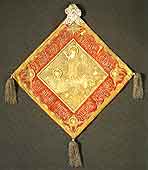
Epigonation. The Resurrection of Christ. Moscow The first three decades of the 18th century.
Donated by Empress Anna Ioannovna in 1730.
|
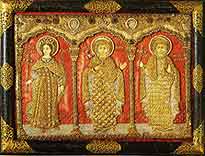
Great Martyrs Catherine, Anna and Paraskeva. Icon. Moscow. 1731. |
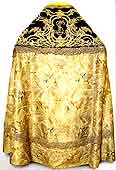
Phelonion. St. Petersburg. Mid-18th century (before 1757).
|
During the rein of Catherine II the royal house was closely connected with the Monastery. Empress visited the Monastery more than once. New vestments were made for the royal court sacristy of the Trinity Archimandrite. The surviving articles are phelonion, epitrachelion, epigonation and sticharion. The vestments are made of silver brocade and embroidered in silks, chenille and golden threads so skillfully that they look like textiles woven by the best European manufactories.
The purificators for church vessels are splendid specimens of the 18th century embroidery. They are of dark green velvet, embroidered in gold and silver and decorated with “gold bullion, fringe and spangles, in the corners there are… four gold bullion tassels”. This set of purificators was embroidered in the royal zhlmeister office. The workshop of the Trinity-St. Sergius Lavra produced the shroud representing “The Entombment”. The Sakkos of Filaret (Drozdov), Metropolitan of Moscow and Kolomna, is a remarkable sample of the 19th century embroidery.
|
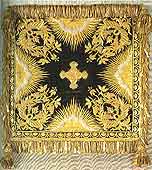
Aer and two purificators. St. Petersburg. 1795. Donated by Empress Catherine II |
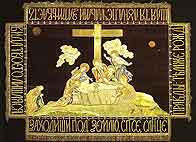
The Entombment. Shroud. 1798. The Trinity-St. Sergius Lavra. Embroidered by P.Ya. Shatilova |
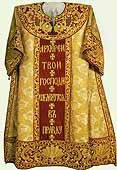
Sakkos. Russia. 19th century. Belonged to Filaret (Drozdov), Metropolitan of Moscow and Kolomna
|
|


